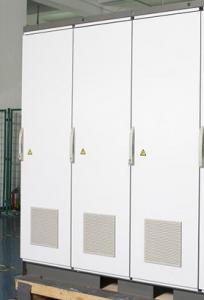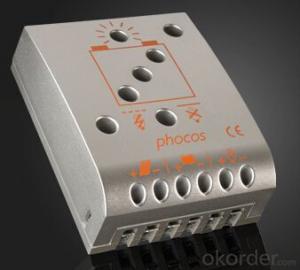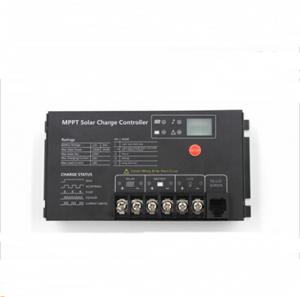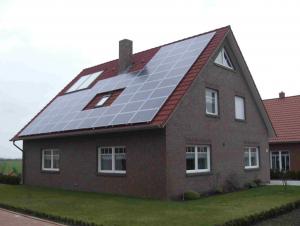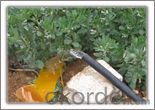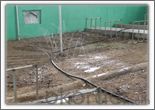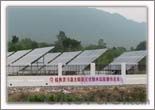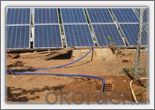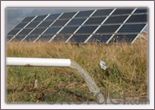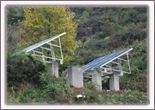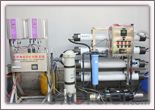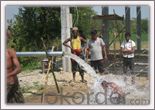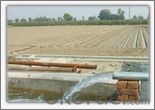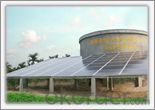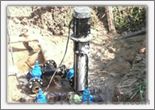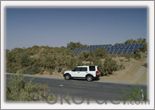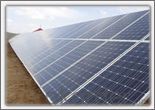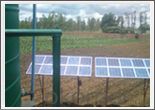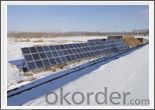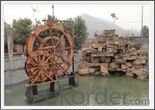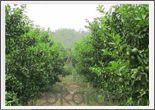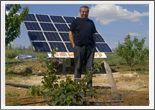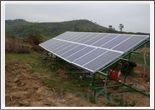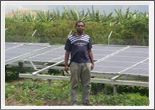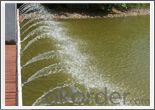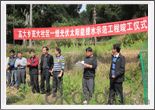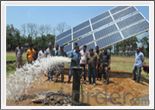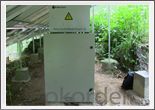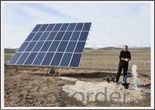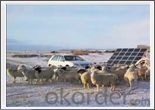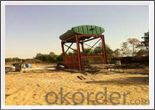DC Solar Water Pump Controller, Pumping System
- Loading Port:
- Shekou
- Payment Terms:
- TT OR LC
- Min Order Qty:
- 20 set
- Supply Capability:
- 100000 set/month
OKorder Service Pledge
OKorder Financial Service
You Might Also Like
Products
Solar Inverter Introduction:
Solar pumping inverter converts DC current from the solar array into AC current to drive the pump. With the function of MPPT (maximum power point tracking), it regulates the output frequency according to irradiation in real time to achieve the maximum power.
Solar Inverters Features:
1. Adopting the proposed dynamic VI maximum power point tracking (MPPT) control method; Fast response and stable operation; Better than the conventional methods which may lead to the problems including poor tracking performances, unstable or even cause water hammer damaging when the irradiation on the array changes rapidly.
2. The solar pumping inverters system is dispensed with energy storing devices, and stores water instead of electricity. It improves the reliability of the device, at the same time, it lowers the construction and maintenance costs of the system dramatically.
3. Digital control; automatic operation and data acquisition/storage of 8 years, etc; 98% of conversion efficiency, and complete protection.
4. In-line blocks; user friendly; convenient for operating; perfect cooling and shielding.
Technical Featrues
Solar Pumping Inverter Advantages:
1. To drive pumps equipped with 3-phase induction motors.
2. Optimized SPWM.
3. Various operation modes and MPPT algorithms are available.
4. Adjustable speed range of pump based on the actual situation of the system.
5. Available option of water-level detecting and control circuit.
6. Protection functions: lightning, over/low input voltage, over current and over load protection, etc.
7. Enclosure class: IP52.
8. Ambient temperature:-10~+50˚C.
Success Stories
►Middle East ►NaQu ►GuiLin
►Turkey ►XiNing ►YunNan
►Army stationed island ►Bangladesh ►Pakistan
►HaiNan ►HuBei ►Uganda
►XinJiang ►NingXia ►Afghan
►Zimbabwe ►Inner Mongolia ►Zhejiang
►Guangxi Guilin ►Turkey2 ►Botswana
►Naning ►Uganda ►Shaanxi
►Tsinghua University ►Pakistan ►Yunnan2
►FuJian ►Banqladesh ►YunNan3
►Turkey ►Inner Mongolia ►Senegal
Product Specifications
Model | Maximum input dc voltage | Recommended MPP Voltage | Rated Output Current | Output Voltage | Output Frequency | Net Weight | Gross Weight | Package Size | ||
Length | Width | Height | ||||||||
PB400L | 450 | 280-350 | 3 | 3PH 220V | 0-50 | 3.4 | 4.9 | 320 | 280 | 225 |
PB750L | 450 | 280-350 | 5 | 3PH 220V | 0-50 | 3.4 | 4.9 | 320 | 280 | 225 |
PF750L | 450 | 150-350 | 5 | 3PH 220V | 0-60 | 6.1 | 7.1 | 425 | 325 | 250 |
PB1500L | 450 | 280-350 | 7 | 3PH 220V | 0-50 | 4.0 | 5.6 | 355 | 280 | 225 |
PF1500L | 450 | 150-350 | 7 | 3PH 220V | 0-60 | 7.5 | 8.5 | 425 | 325 | 285 |
PB2200L | 450 | 280-350 | 11 | 3PH 220V | 0-50 | 4.0 | 5.6 | 355 | 280 | 225 |
PF2200L | 450 | 150-350 | 11 | 3PH 220V | 0-60 | 7.9 | 9.0 | 425 | 325 | 285 |
PB3700LA | 450 | 280-350 | 17 | 3PH 220V | 0-50 | 7.2 | 9.5 | 425 | 325 | 285 |
PB5500LA | 450 | 280-350 | 25 | 3PH 220V | 0-50 | 7.3 | 9.6 | 425 | 325 | 285 |
PB3700H | 750 | 500-600 | 9 | 3PH 380V | 0-50 | 7.2 | 9.5 | 425 | 325 | 285 |
PB5500H | 750 | 500-600 | 13 | 3PH 380V | 0-50 | 7.3 | 9.6 | 425 | 325 | 285 |
PB7500H | 750 | 500-600 | 18 | 3PH 380V | 0-50 | 7.7 | 10 | 425 | 325 | 285 |
PB11KH | 750 | 500-600 | 24 | 3PH 380V | 0-50 | 8.2 | 10.5 | 425 | 325 | 285 |
PB15KH | 750 | 500-600 | 30 | 3PH 380V | 0-50 | 8.4 | 10.7 | 425 | 325 | 285 |
PB18KH | 750 | 500-600 | 39 | 3PH 380V | 0-50 | 8.4 | 10.7 | 425 | 325 | 285 |
PB22KH | 750 | 500-600 | 45 | 3PH 380V | 0-50 | 18 | 21 | 600 | 465 | 350 |
PB30KH | 750 | 500-600 | 60 | 3PH 380V | 0-50 | 18 | 21 | 600 | 465 | 350 |
PB37KH | 750 | 500-600 | 75 | 3PH 380V | 0-50 | 20 | 23 | 600 | 465 | 350 |
PB45KH | 750 | 500-600 | 91 | 3PH 380V | 0-50 | 20 | 23 | 600 | 465 | 350 |
PB55KH | 750 | 500-600 | 112 | 3PH 380V | 0-50 | 20 | 23 | 600 | 465 | 350 |
- Q:What is the maximum charging temperature a solar controller can handle?
- The maximum charging temperature a solar controller can handle depends on the specific model and manufacturer. However, in general, most solar controllers can handle charging temperatures up to 113°F (45°C). It is important to refer to the product's specifications or consult with the manufacturer for the exact maximum charging temperature for a specific solar controller.
- Q:Are there any disadvantages to using a solar controller?
- Yes, there are a few disadvantages to using a solar controller. Firstly, solar controllers can be expensive to purchase and install, which may deter some individuals or businesses from investing in solar energy systems. Additionally, solar controllers require regular maintenance and monitoring to ensure optimal performance, which can add to the overall cost and effort involved in using solar energy. Finally, solar controllers are dependent on sunlight, so they may not be as effective in areas with limited sunlight or during cloudy weather conditions.
- Q:What is the maximum voltage a solar controller can handle?
- The maximum voltage a solar controller can handle depends on its design and specifications. However, typical solar controllers can handle voltages ranging from 12 volts to 48 volts, with some specialized controllers capable of handling higher voltages. It is essential to refer to the manufacturer's specifications and guidelines to ensure the solar controller can handle the specific voltage of your solar system.
- Q:What is the size and weight of a typical solar controller?
- The size and weight of a typical solar controller can vary depending on the specific model and brand. However, most solar controllers are relatively compact and lightweight. They are typically small enough to fit in the palm of your hand and can weigh anywhere from a few ounces to a few pounds.
- Q:How does a solar controller handle the protection against short circuits?
- A solar controller handles protection against short circuits by monitoring the current flow from the solar panels. If a short circuit occurs, the controller will detect the sudden increase in current and immediately shut off the circuit to prevent any damage to the panels or other connected devices. This is done through the use of built-in circuitry or fuses that can quickly interrupt the flow of electricity in case of a short circuit.
- Q:Can a solar controller be used with solar panels that are partially covered?
- Yes, a solar controller can be used with partially covered solar panels. However, the efficiency of the solar panels may be reduced depending on the extent of the coverage. It is important to ensure that the solar controller is properly set up and programmed to optimize the energy output from the partially covered solar panels.
- Q:Solar street light controller only one button and digital display, would like to ask experts to learn how to design his time, the power is mainly want to know the specific mode of operation, please help explain the master
- Pure light control (0): When there is no sunlight, the light intensity drops to the starting point, the controller delay 10 minutes to confirm the start signal, according to the set parameters to open the load, the load began to work; when there is sunlight, light intensity to start Point, the controller delay 10 minutes to confirm the closure of the signal after the closure of the output, the load stops working.
- Q:What is the maximum cable size that can be used between the solar panels and the solar controller?
- The maximum cable size that can be used between the solar panels and the solar controller depends on various factors such as the distance between the panels and the controller, the current capacity of the panels, and the voltage drop limitations. Generally, it is recommended to use larger cable sizes to minimize voltage drop and ensure efficient power transmission. To determine the maximum cable size, one needs to consider the current carrying capacity of the cable and the voltage drop over the distance. The current carrying capacity is usually defined by the manufacturer and can be found in the cable specifications. It is essential to select a cable that can handle the maximum current generated by the solar panels. Voltage drop is another critical factor to consider. Voltage drop occurs due to the resistance of the cable, and it can affect the overall performance and efficiency of the solar system. The acceptable voltage drop varies depending on the system's requirements, but a general guideline is to keep it below 3% for optimal performance. To calculate the maximum cable size, one can use the voltage drop formula and the current capacity of the cable. By considering the distance between the panels and the controller, the current generated by the panels, and the acceptable voltage drop, one can determine the appropriate cable size. It is advisable to consult with a professional or refer to the manufacturer's guidelines for the specific solar panels and controller being used. They can provide accurate recommendations based on the system's requirements and ensure the maximum cable size is chosen for optimal performance and safety.
- Q:What is the maximum charging current a solar controller can provide?
- The maximum charging current a solar controller can provide depends on its specifications and capabilities, but it is typically in the range of 10 to 60 amps.
- Q:How does a solar controller handle overvoltage protection?
- A solar controller handles overvoltage protection by continuously monitoring the voltage level of the solar panels. If the voltage exceeds a certain threshold, the controller automatically activates a mechanism to limit the voltage, such as diverting excess power to a secondary load or by temporarily disconnecting the panels from the battery bank. This helps prevent any damage to the system caused by overvoltage and ensures the safe and efficient operation of the solar power setup.
1. Manufacturer Overview |
|
|---|---|
| Location | |
| Year Established | |
| Annual Output Value | |
| Main Markets | |
| Company Certifications | |
2. Manufacturer Certificates |
|
|---|---|
| a) Certification Name | |
| Range | |
| Reference | |
| Validity Period | |
3. Manufacturer Capability |
|
|---|---|
| a)Trade Capacity | |
| Nearest Port | |
| Export Percentage | |
| No.of Employees in Trade Department | |
| Language Spoken: | |
| b)Factory Information | |
| Factory Size: | |
| No. of Production Lines | |
| Contract Manufacturing | |
| Product Price Range | |
Send your message to us
DC Solar Water Pump Controller, Pumping System
- Loading Port:
- Shekou
- Payment Terms:
- TT OR LC
- Min Order Qty:
- 20 set
- Supply Capability:
- 100000 set/month
OKorder Service Pledge
OKorder Financial Service
Similar products
New products
Hot products
Hot Searches
Related keywords






